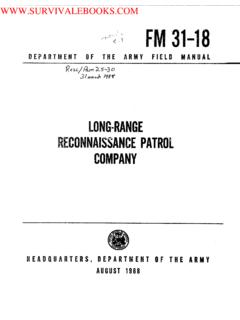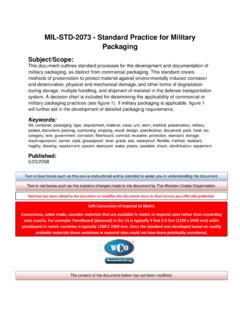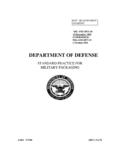Transcription of FM 55-312 Military Convoy Operations in CONUS 1991
1 55-312 PREFACE This manual is for installation and unit movement coordinators, unit movement officers, Convoy commanders, officers, and noncommissioned officers as guidance for planning, administration, and operation of convoys within the continental United States ( CONUS ). It conforms with ARs 55-29 and 55-162 and sets forth the procedures described in FORSCOM Regulation 55-1, implementing those functions associated with the Convoy management system known as mobilization movement control (MOBCON). Also described are the functions and responsibilities of the state area command (STARC), the state movement control center (SMCC), the logistical support agencies (LSA), and the Office of Deputy Chief of Staff for Logistics (ODCSLOG), in their responsibility for the publication and distribution of the numbered armies in the continental United States (CONUSA) support directories and their relationship to the user in preparation for Convoy movements.
2 The procedures for MOBCON are applicable for all CONUS active Army, Army National Guard (ARNG), US Army Reserve (USAR) units, and all other Department of Defense (DOD) organizations involved in Convoy Operations . Physical considerations for the preparation of convoys are described to ensure the maximum safety for personnel, vehicles, and cargo. Included are the requirements for preparing the drivers, communications, Convoy organizational element lengths, vehicle and Convoy identification, and highway discipline. When the procedures prescribed by this text conflict with local and/or state traffic laws, the local and state laws will apply.
3 The proposed target dates for implementing MOBCON as a total operational system is 2d QTR FY 91 for the ARNG and USAR units and FY 92 for the active DOD units. Unless this publication states otherwise, masculine nouns and pronouns do not refer exclusively to men. This publication contains copyrighted material. The proponent of this publication is HQ TRADOC. Send comments and recommendations on DA Form 2028 (Recommended Changes to Publications and Blank Forms) directly to Commandant, US Army Transportation School, ATTN: ATSP-TDL, Fort Eustis, VA 23604-5399. iv 55-312 REFERENCES These are the sources quoted or paraphrased in this publication.
4 AR 5-9. Intraservice Support Installation Area Coordination. 1 March 1984. AR 55-29. Military Convoy Operations in CONUS . July 1973. AR 55-162. Permits for Oversize, Overweight, or Other Special Military Movements on Public Highways in the United States. 1 January 1970. AR 55-355. Defense Traffic Management Regulation. 31 July 1986. AR 55-355. Vol 2, Transportation Facility Guide (TFG) Records US Army. 30 September 1987. AR 190-5. Motor Vehicle Traffic Supervision. 8 July 1988. AR 385-40. Accident Reporting and Records. 1 April 1987. AR 385-55. Prevention of Motor Vehicle Accidents. 12 March 1987. AR 600-55. Motor Vehicle Driver and Equipment Operator Selection, Training, Testing, and Licensing.
5 26 September 1986. FR 55-1. Transportation and Travel (Unit Movement Planning) FM 5-36. Route Reconnaissance and Classification. 10 May 1985. FM 8-35. Evacuation of the Sick and Wounded. 22 December 1983. FM 19-25. Military Police Traffic Operations . 30 September 1977. FM 20-22. Vehicle Recovery Operations . 31 August 1984. FM 21-11. First Aid for Soldiers. 27 October 1988. FM 21-17. Drive reelection, Training, and Supervision, Track Combat Vehicles. 11 December 1981. FM 21-26. Map Reading and Land Navigation. 30 September 1987. FM 21-60. Visual Signals 30 September 1987. FM 21-305. Manual for the Wheeled Vehicle Driver.
6 24 September 1984. FM 55-15. Transportation Reference 9 June 1986. FM 55-30. Army Motor Transport Units and Operations . 14 March 1980. FM 55-65. Strategic Deployment by Surface Transportation. 10 May 1989. FM 101-5. Staff Organization and Operations . 25 May 1984. FM 101-5-1. Operational Terms and Symbols. 21 October 1985. I M 9-500. Data Sheets for Ordnance Type Materiel. 6 October 1967. TB 5546-1. Standard Characteristics (Dimensions, Weights, and Cube) for Transportability of Military Vehicles and Other Outsize/Overweight Equipment. TB 55-46-2. Standard Transportability Characteristics (Dimensions, Weight, and Cube) for Military Vehicles and Equipment.
7 15 January 1990. References-1 55-312 DA Form 285. US Army Accident Investigation Report. August 1980. DD Form 1265. Request for Convoy Clearance. January 1959. DD Form 1266. Request for Special Hauling 1959. SF 91. Operator Report on Motor Vehicle Accidents. November 1976. DA Pam 310-10. The Standard Army Publications System (STARPUBS): Users Guide 1 October 1982. DA Pam 738-750. The Army Maintenance Management System (TAMMS). 15 January 1988. References-2 55-312 CHAPTER 1 MOBILIZATION MOVEMENT AND CONTROL (MOBCON) MOTOR CONVOYS Within CONUS , a motor Convoy is a group of vehicles organized for the purpose of control and orderly move ment with or without escort protection.
8 A motor Convoy will include- Any group of six or more vehicles temporarily organized to operate as a column, with or without escort, proceeding together under a single com mander. Ten or more vehicles per hour dispatched to the same destination, over the same route (except during mobilization and deployment, then all movements to a mobilization station will require a Convoy clearance). Five or fewer vehicles operating as a column, with or without escort, proceeding under a single com mander (if one or more vehicles require the sub mission of a DD Form 1266). Convoy MOVEMENT AND CONTROL A Military Convoy in CONUS cannot travel on the public highways without an approved Convoy clearance.
9 (AR 55-29 and AR 55-162 are being revised to comply with FORSCOM Regulation 55-1 which implements the MOBCON procedures.) Several government agencies are involved in the planning and execution of Military convoys moving within the continental United States ( CONUS ). These agencies practice relatively the same procedures in peacetime as they do during mobilization. This chapter discusses these agencies and their role as it relates to Military convoys operating in CONUS . US ARMY FORCES COMMAND (FORSCOM) FORSCOM, FCJ4 is the proponent for the MOBCON program being implemented by the Army National Guard (ARNG). MOBCON places authority for ap proval of Military convoys in the ARNG State Area Command (STARC) in each state.
10 (Until all states have operational MOBCON systems, only RC and NG units must obtain tommy clearance approval through the ARNG STARC. Upon FORCOM order, active com ponent units will be required to obtain Convoy clearance approval through the ARNG STARC.) The STARC refers to the premobilization organization. Upon mobilization, the STARC will then be refereed to as the Joint State Area Command (JSAC). Within each STARC, there is a state movement control center (SMCC). NUMBERED ARMIES IN THE CONTINENTAL UNITED STATES (CONUSA) The United States is divided into five CONUSAs. Each of these commands is responsible for the Military opera tions that take place within its respective Army area (see Figure 1-1).









